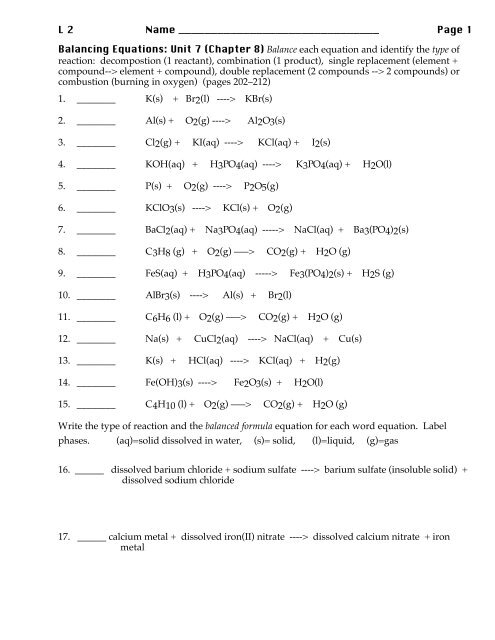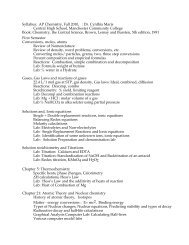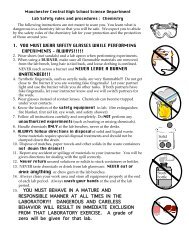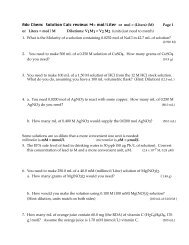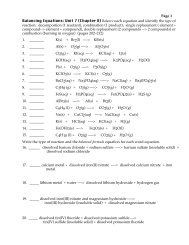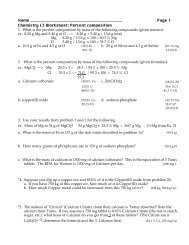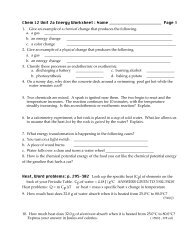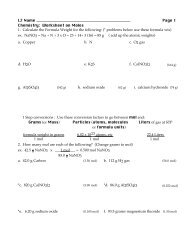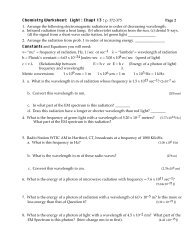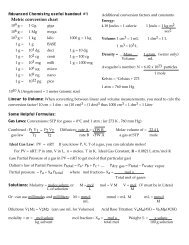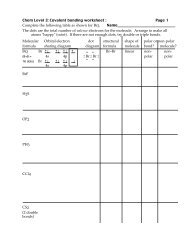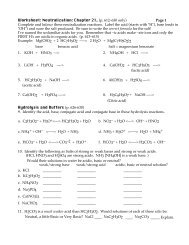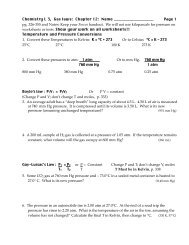Worksheet Balancing Equations
Worksheet Balancing Equations
Worksheet Balancing Equations
You also want an ePaper? Increase the reach of your titles
YUMPU automatically turns print PDFs into web optimized ePapers that Google loves.
L 2 Name _______________________________ Page 1<br />
<strong>Balancing</strong> <strong>Equations</strong>: Unit 7 (Chapter 8) Balance each equation and identify the type of<br />
reaction: decompostion (1 reactant), combination (1 product), single replacement (element +<br />
compound--> element + compound), double replacement (2 compounds --> 2 compounds) or<br />
combustion (burning in oxygen) (pages 202–212)<br />
1. ________ K(s) + Br2(l) ----> KBr(s)<br />
2. ________ Al(s) + O2(g) ----> Al2O3(s)<br />
3. ________ Cl2(g) + KI(aq) ----> KCl(aq) + I2(s)<br />
4. ________ KOH(aq) + H3PO4(aq) ----> K3PO4(aq) + H2O(l)<br />
5. ________ P(s) + O2(g) ----> P2O5(g)<br />
6. ________ KClO3(s) ----> KCl(s) + O2(g)<br />
7. ________ BaCl2(aq) + Na3PO4(aq) -----> NaCl(aq) + Ba3(PO4)2(s)<br />
8. ________ C3H8 (g) + O2(g) –––> CO2(g) + H2O (g)<br />
9. ________ FeS(aq) + H3PO4(aq) -----> Fe3(PO4)2(s) + H2S (g)<br />
10. ________ AlBr3(s) ----> Al(s) + Br2(l)<br />
11. ________ C6H6 (l) + O2(g) –––> CO2(g) + H2O (g)<br />
12. ________ Na(s) + CuCl2(aq) ----> NaCl(aq) + Cu(s)<br />
13. ________ K(s) + HCl(aq) ----> KCl(aq) + H2(g)<br />
14. ________ Fe(OH)3(s) ----> Fe2O3(s) + H2O(l)<br />
15. ________ C4H10 (l) + O2(g) –––> CO2(g) + H2O (g)<br />
Write the type of reaction and the balanced formula equation for each word equation. Label<br />
phases. (aq)=solid dissolved in water, (s)= solid, (l)=liquid, (g)=gas<br />
16. ______ dissolved barium chloride + sodium sulfate ----> barium sulfate (insoluble solid) +<br />
dissolved sodium chloride<br />
17. ______ calcium metal + dissolved iron(II) nitrate ----> dissolved calcium nitrate + iron<br />
metal
Page 2<br />
18. _____ lithium metal + water ----> dissolved lithium hydroxide + hydrogen gas<br />
19. _____ dissolved iron(III) nitrate and magnesium hydroxide ----><br />
iron(III) hydroxide (insoluble solid) + dissolved magnesium nitrate<br />
20. _____ dissolved tin(IV) fluoride + dissolved potassium sulfide ---><br />
tin(IV) sulfide (insoluble solid) + dissolved potassium fluoride<br />
21. _____ solid sulfur + oxygen gas ----> sufur trioxide gas<br />
Predict the products (Correct formulas!!) and balance the following reactions.<br />
Combination reactions: Make the binary ionic compound from the elements. (p.212-214)<br />
Example: For K + O2 ––––> answer is 4 K + O2 ––––> 2 K2O (K + O –2 )<br />
22. Al + Br2 -----> 23. Na + O2 ----><br />
Decomposition reactions: Decompose into elements when electricity is added. (p. 214 -216)<br />
Example: NaF –––> answer is 2 NaF –––> 2 Na + F2 (F2 is diatomic)<br />
electricity<br />
elect.<br />
24. HF --------------> 25. MgO ---––-><br />
Complete combustion of a hydrocarbon: O2 gas is a reactant, Products are CO2, H2O<br />
Ex: Complete Combustion of C6H6: Answer: 2 C6H6 + 15 O2 –––> 12 CO2 + 6 H2O (220-222)<br />
26. Complete combustion of C8H18<br />
27. Complete combustion of CH3OH<br />
Incomplete combustion of a hydrocarbon: O2 gas is a reactant, Products are CO, H2O<br />
Ex: Incomplete Combustion of C6H6: Ans: 2 C6H6 + 9 O2 –––> 12 CO + 6 H2O<br />
28. Incomplete combustion of C4H10
L2 Name _____________________________ page 3<br />
29. Incomplete combustion of C3H6<br />
Predicting Single replacement : (Element + compound––> element + compound,<br />
Use the Activity Series: Reacts if the element alone is more active than [above] the element in the<br />
compound. Complete and Balance only if it is a yes! (p. 216-218)<br />
30. HCl(aq) + K(s) ----><br />
31. Cu(s) + NaCl(aq) ----><br />
32. Al(s) + Pb(NO3)2(aq) ----><br />
33. AgNO3(aq) + Mg(s) ----><br />
34. Li(s) + H2O(l) –––><br />
(Halogens) special case !!!!!<br />
35. Cl2(g) + NaBr(aq) –––><br />
36. Br2(l) + KF (aq) –––><br />
37. MgI2(aq) + F2 (g) –––><br />
Predict the products, balance: Double replacement :(2 compounds–>2 compounds,<br />
Use Solubility Chart: Only Reacts IF one product is an Insoluble solid, water or a gas)<br />
(p. 218-220)<br />
1. CaI2(aq) + AgNO3(aq) -----><br />
2. Sr(NO3)2(aq) + Al2(SO4)3(aq) -----><br />
3. KNO3(aq) + NaCl(aq) ---->
Page 4<br />
4. Na2CO3(aq) + CaCl2(aq) ----><br />
5. H2SO4(aq) + Mg(OH)2(aq) -----><br />
6. BaCl2(aq) + Na3PO4(aq) -----><br />
Chemistry : Final worksheet for balancing equations<br />
Identify the type of each reaction (SR, DR, combo, decomp, combustion) Then, balance them.<br />
1. ________ Fe(s) + O2(g) ----> Fe2O3(s)<br />
2. ________ Zn(s) + AgNO3(aq) ----> Zn(NO3)2(aq) + Ag(s)<br />
3. ________ HCl(aq) + Ca(OH)2(s) ----> CaCl2(aq) + H2O(l)<br />
4. ________ SrCl2(aq) + Na3PO4(aq) -----> Sr3(PO4)2(s) + NaCl(aq)<br />
5. ________ C6H12O6(s) + O2(g) –––> CO2(g) + H2O (g)<br />
6. ________ NaCl (l) ----> Na(l) + Cl2(g)<br />
7. ________ Br2(l) + NaI(aq) ----> NaBr(aq) + I2(s)<br />
8. ________ FeCl3(aq) + Ca(OH)2(aq) ----> Fe(OH)3(s) + CaCl2(aq)<br />
9. ________ AlCl3(s) ----> Al(s) + Cl2(g)<br />
10. ________ C6H14 (l) + O2(g) –––> CO2(g) + H2O(g)<br />
11. _______ Cu(s) + Al(NO3)3(aq) ----> Cu(NO3)2(aq) + Al(s)<br />
12. _______ H2SO4(aq) + Al(OH)3(aq) ----> Al2(SO4)3(aq) + H2O(l)<br />
13. DR + Decomp MgCO3(aq) + HNO3(aq) ----> Mg(NO3)2(aq) + H2O(l) + CO2(g)<br />
14. _______ Pb(NO3)2(s) ----> PbO(s) + NO2(g) + O2(g)<br />
Write the type of reaction and the balanced formula equation for each word equation.<br />
Label phases<br />
15. _______ solid phosphorus + oxygen gas ----> solid diphosphorus pentoxide<br />
16. _______ copper metal + chlorine gas ---> solid copper(I) chloride
L 2 Name _______________________________ Page 5<br />
17. _______ zinc metal + iron(II) nitrate ---> iron metal + zinc nitrate<br />
18. _______ dissolved sodium phosphate and barium chloride ---> dissolved sodium chloride +<br />
Insoluble solid Barium phosphate<br />
19. _______ potassium metal + water ---> dissolved potassium hydroxide + hydrogen gas<br />
20. _______ solid magnesium oxide plus water ---> dissolved magnesium hydroxide<br />
Predict the Products and Balance: In addition, for the SR and DR, list the type of<br />
reaction and tell WHY it reacts or doesn't react. (p. 222-224)<br />
Type<br />
Reason<br />
21. ______ K2CO3(aq) + Ca(NO3)2(aq) ----><br />
22. ______ Mg(s) + AgNO3(aq) ---><br />
23. ______ Ca(OH)2(s) + HCl(aq) ----><br />
24.Combination Na(s) + Br2(l) –––><br />
25. ______ KNO3(aq) + MgSO4(aq) -----><br />
26. ______ Pb(s) + MgI2(aq) -----><br />
27. Complete combustion: C5H10 + –––><br />
28. ______ Al(s) + H2SO4(aq) ----><br />
electricity<br />
29. Decomp KI ––––––––><br />
30. ______ Na(s) + H2O(l) –––><br />
31. ______ Na3PO4(aq) + MgBr2(aq) ---><br />
32. ______ FeCl2(aq) + Na(s) --->


